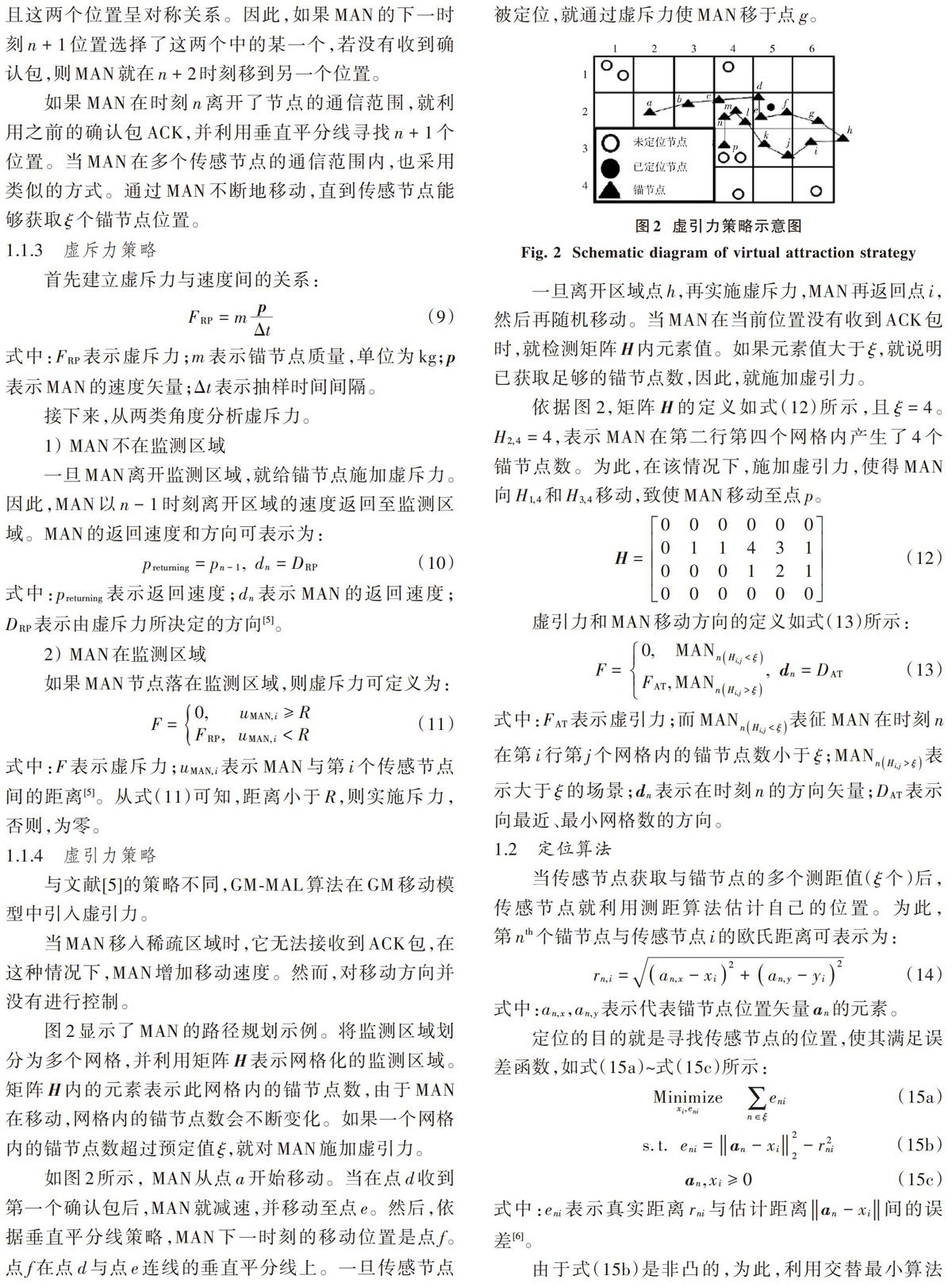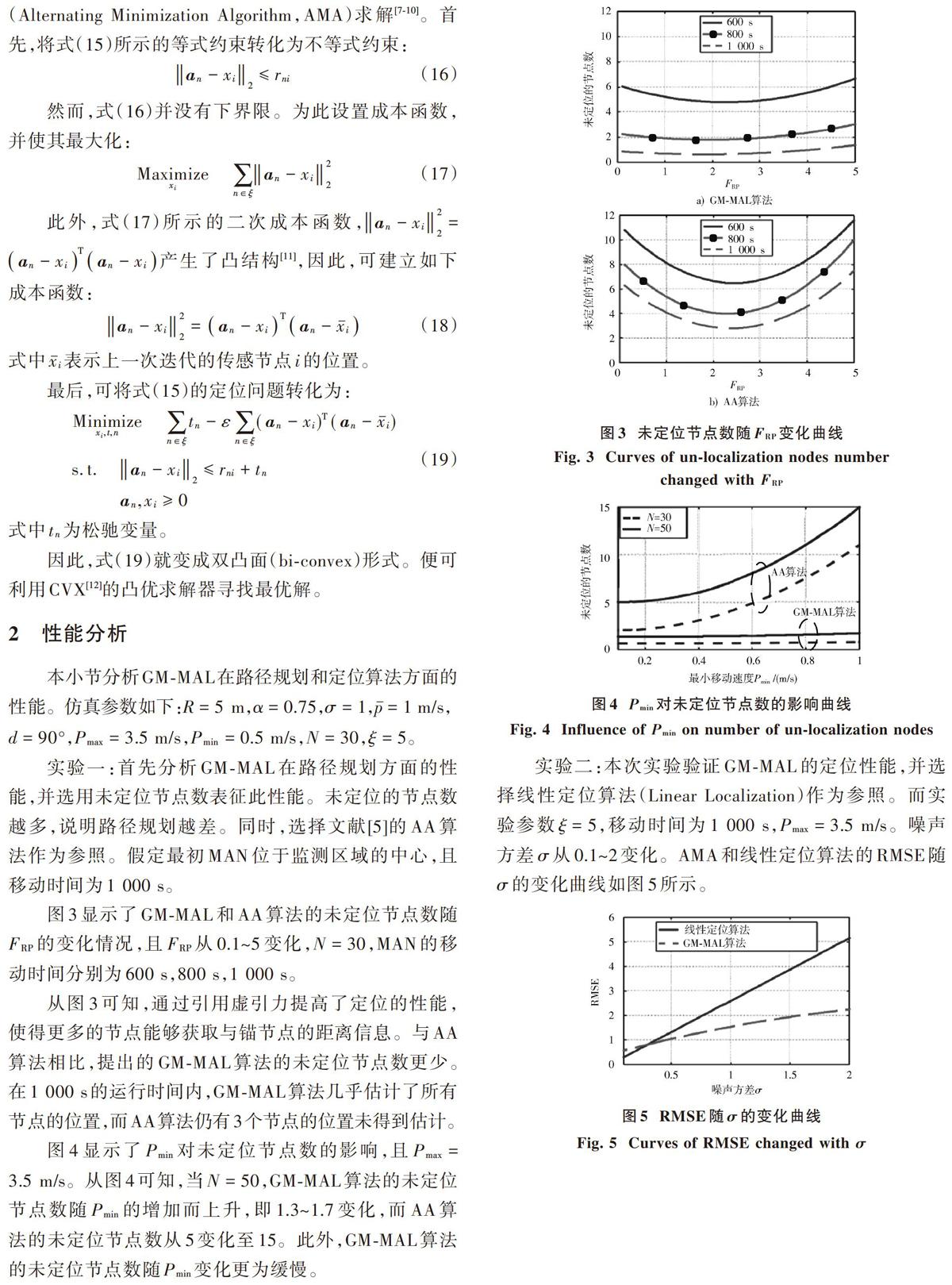基于移动锚节点的无线传感网络节点定位算法
彭凤英 焦键
关键词: 无线传感网络; 定位; 移动模型; 路径规划; 交替最小算法; 移动锚节点
中图分类号: TN915.02?34; TP393 文献标识码: A 文章编号: 1004?373X(2019)03?0018?05
Abstract: The anchor node position plays an important role for accurate node localization in wireless sensor networks (WSNs). Therefore, a Gauss?Markov?based mobile anchor?localization (GM?MAL) algorithm is proposed in this paper. An adaptive mobile path planning of anchor node is proposed on the basis of Gauss?Markov mobility model. The strategies of velocity adjustment, perpendicular bisector, virtual repulsion and virtual attraction are used to plan the path in path planning stage. The non?convex optimization problem is converted into a bi?convex form, and solved with alternating minimization algorithm (AMA), which can acquire a shorter mobile path of anchor node. The experimental data shows that the virtual attraction strategy can improve the path planning accuracy, and cover more surveillance regions. In comparison with linear localization algorithm, the GM?MAL algorithm can improve the localization accuracy.
Keywords: wireless sensor network; localization; mobile model; path planning; alternating minimization algorithm; mobile anchor node
0 引 言
无线传感网络(Wireless Sensor Networks,WSNs)已广泛应用在各个领域中,如森林火灾检测、战场侦察、入侵检测、目标跟踪以及健康康复等[1?2]。部署于WSNs内的传感节点实时感测环境数据,然后再将数据传输至控制中心,进而实现对环境区域的监测。然而,感测数据必须附加较准确的位置信息,一旦离开了位置数据,感测数据就失去意义。因此,节点定位成为WSNs的研究热点之一[3]。
目前,现有的定位算法可分为测距和非测距两类。其中非测距算法利用传感节点与锚节点间的连通性,而测距算法是利用节点与节点间的距离或角度信息估计节点位置[4]。相比非测距定位算法,测距算法的定位精度较高。
在测距定位算法中,锚节点位置对定位精度有重要的影响。通常,锚节点数越多,定位精度越高。然而,增加锚节点数也会增加定位成本。此外,在静态锚节点场景中,一旦对传感节点定位后,这些锚节点就不再有价值,因为节点是静态的,网络拓扑不会发生变化。因此,利用移动的锚节点策略,并由移动锚节点不断广播它的位置,在提高定位精度的同时,降低定位成本[5]。
为此,本文提出基于高斯?Markov(Gauss?Markov,GM)移动模型的移动锚节点的节点定位算法(Gauss?Markov?based Mobile Anchor?localization,GM?MAL)。GM?MAL算法先规划移动路径,锚节点依据此路径移动,并实时调整移动速度和方向,在移动过程中,锚节点不断广播自己的位置信息,使得周围的传感节点能获取与锚节点的距离信息,即测距。当传感节点获取足够多的测距值后,传感节点便可估计自己的位置。
1 GM?MAL
GM?MAL算法主要由锚节点移动路径规划和定位两部分组成。即先制订锚节点的移动路径,然后,锚节点依据此路径移动,使得传感节点能够获取与锚节点的距离信息;随后,传感节点再依据距离信息估计自己的位置。
1.1 路径规划
从图5可知,当[σ>0.3]后,提出的GM?MAL定位算法的RMSE低于同类的线性定位算法,并且随[σ]的增加,优越性越发特出。例如,当[σ]=2时,GM?MAL算法的RMSE约为2.2,而线性定位算法的RMSE达到5.2。这些数据表明,提出的AMA定位算法能够估计目标位置。




从图5可知,当[σ>0.3]后,提出的GM?MAL定位算法的RMSE低于同类的线性定位算法,并且随[σ]的增加,优越性越发特出。例如,当[σ]=2时,GM?MAL算法的RMSE约为2.2,而线性定位算法的RMSE达到5.2。这些数据表明,提出的AMA定位算法能够估计目标位置。
3 结 语
针对无线传感网络的节点定位问题,本文提出GM?MAL算法。GM?MAL算法针对移动锚节点,提出基于GM移动模型的路径规划算法,并利用AMA算法估计节点位置。通过引入虚引力,对MAN的移动方向进行控制。此外,将定位问题的非凸结构转化为双凸形式,进而利用AMA算法求解。实验数据表明,虚引力策略增加了定位节点数,此外,应用AMA算法提高了定位精度。
参考文献
[1] YANG L, YANG L, HO K C. Moving target localization in multistatic sonar by differential delays and Doppler shifts [J]. IEEE signal processing letters, 2016, 23(9): 1160?1164.
[2] NOROOZI A, SEBT M A. Target localization in multistatic passive radar using SVD approach for eliminating the nuisance parameters [J]. IEEE transactions on aerospace and electronic systems, 2017, 53(4): 1660?1671.
[3] FISHLER E, HAIMOVICH A, BLUM R, et al. Spatial diversity in radars?models and detection performance [J]. IEEE tran?sactions on signal processing, 2006, 54(3): 823?838.
[4] GODRICH H, HAIMOVICH A M, BLUM R S. Target localisation techniques and tools for multiple?input multiple?output radar [J]. IET radar, sonar and navigation, 2015, 3(4): 314?327.
[5] YANG H, CHUN J. An improved algebraic solution for moving target localization in noncoherent MIMO radar systems [J]. IEEE transactions on signal processing, 2016, 64(1): 258?270.
[6] LI J, STOICA P. MIMO radar with colocated antennas [J]. IEEE signal processing magazine, 2017, 24(5): 106?114.
[7] NOROOZI A, SEBT M A. A new estimator for elliptic localization in distributed MIMO radar systems [C]// Proceedings of 2017 Iranian Conference on Electrical Engineering. Tehran: IEEE, 2017: 1615?1618.
[8] DIANAT M, TABAN M R, DIANAT J, et al. Target localization using least squares estimation for MIMO radars with widely separated antennas [J]. IEEE transactions on aerospace electronic systems, 2013, 49(4): 2730?2741.
[9] EINEMO M, SO H C. Weighted least squares algorithm for target localization in distributed MIMO radar [J]. Signal proces?sing, 2015,115(4): 144?150.
[10] NOROOZI A, SEBT M A. Target localization from bistatic range measurements in multi?transmitter multi?receiver passive radar [J]. IEEE signal processing letters, 2015, 22(12): 2445?2449.
[11] NOROOZI A, SEBT M A. Weighted least squares target location estimation in multi?transmitter multi?receiver passive radar using bistatic range measurements [J]. IET radar, sonar and navigation, 2016, 10(6): 1088?1097.
[12] GODRICH H, HAIMOVICH A M, BLUM R S. Target loca?lization accuracy gain in MIMO radar?based systems [J]. IEEE transactions on information theory, 2010, 56(6): 2783?2803.

